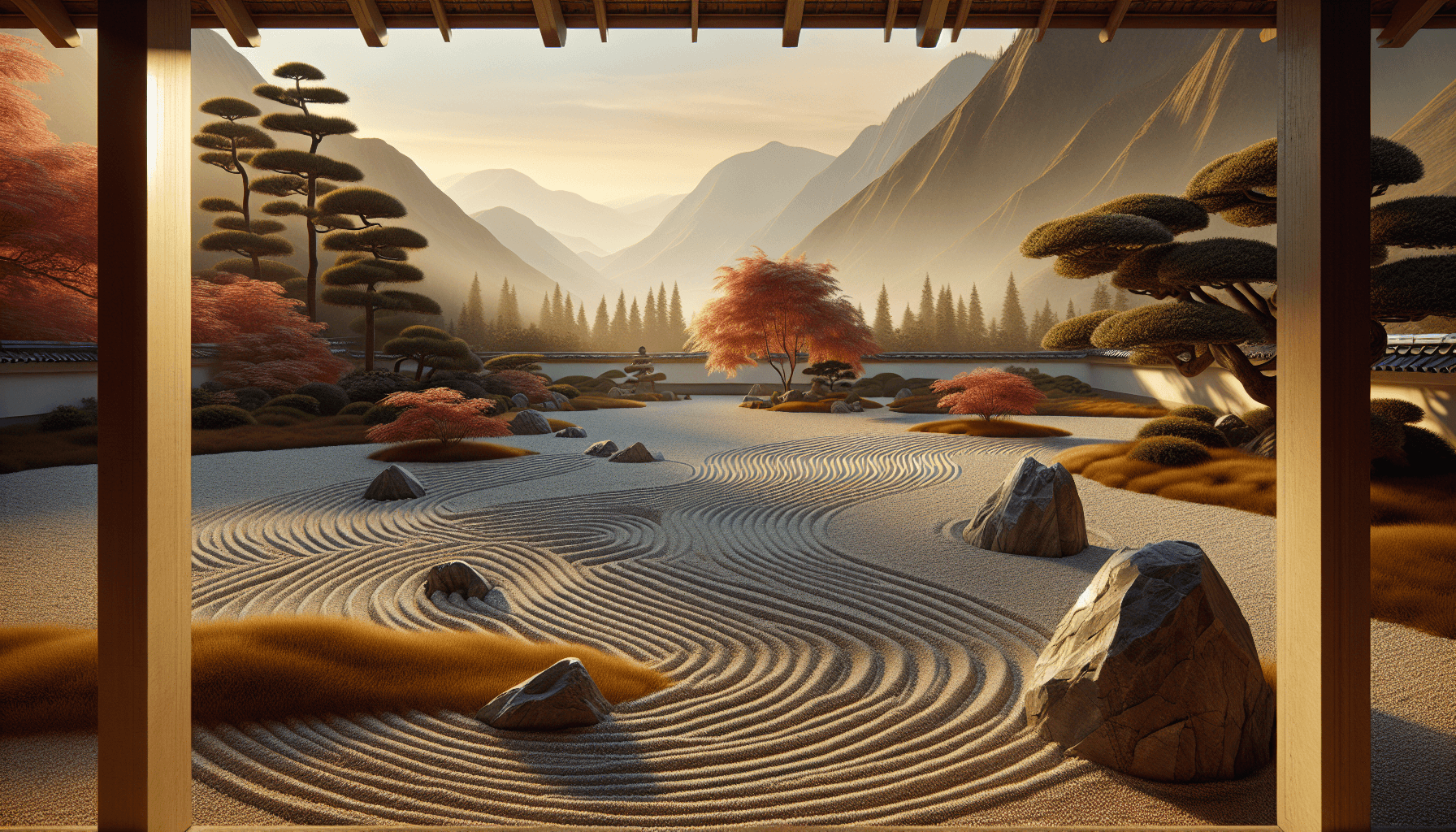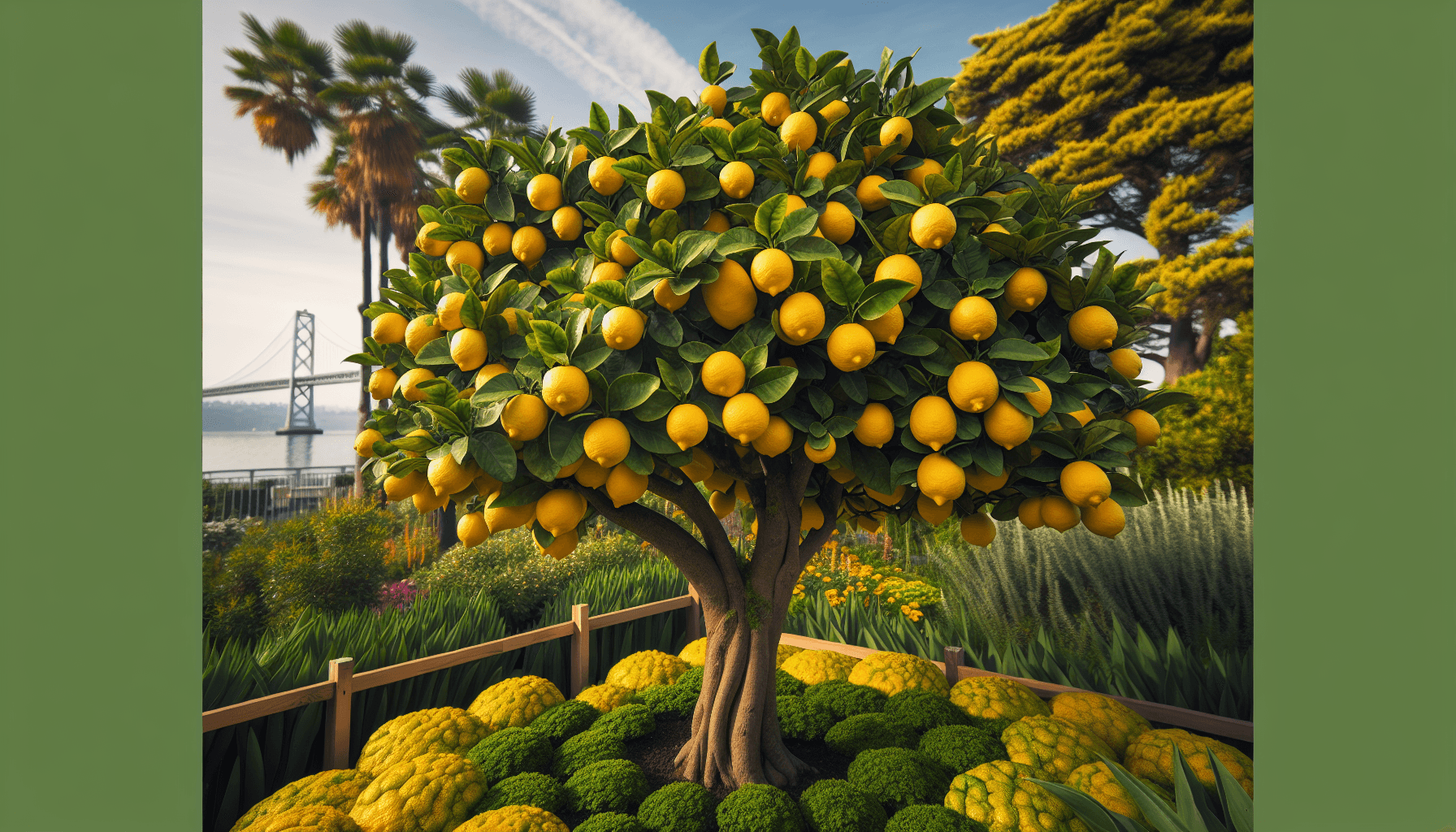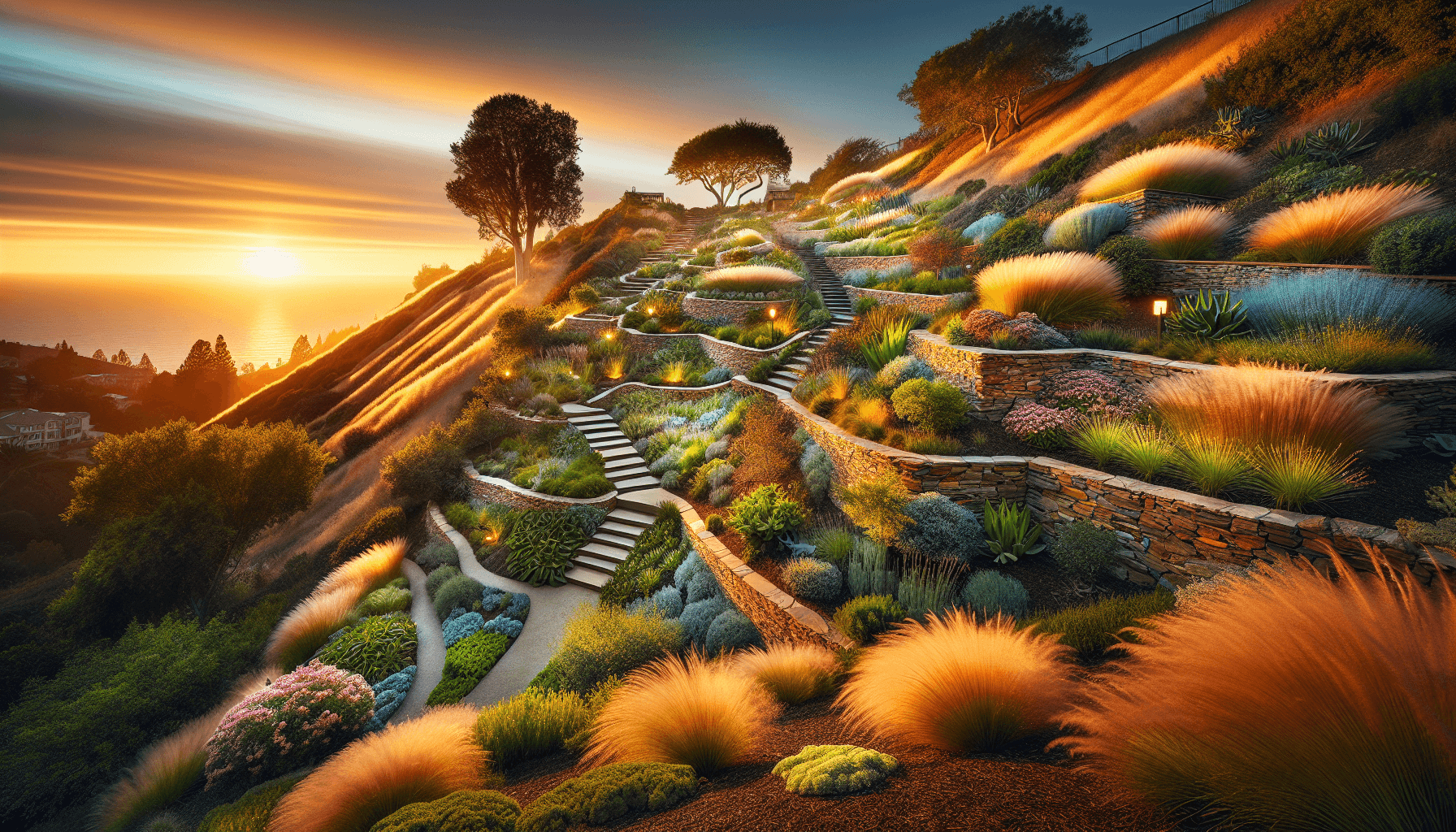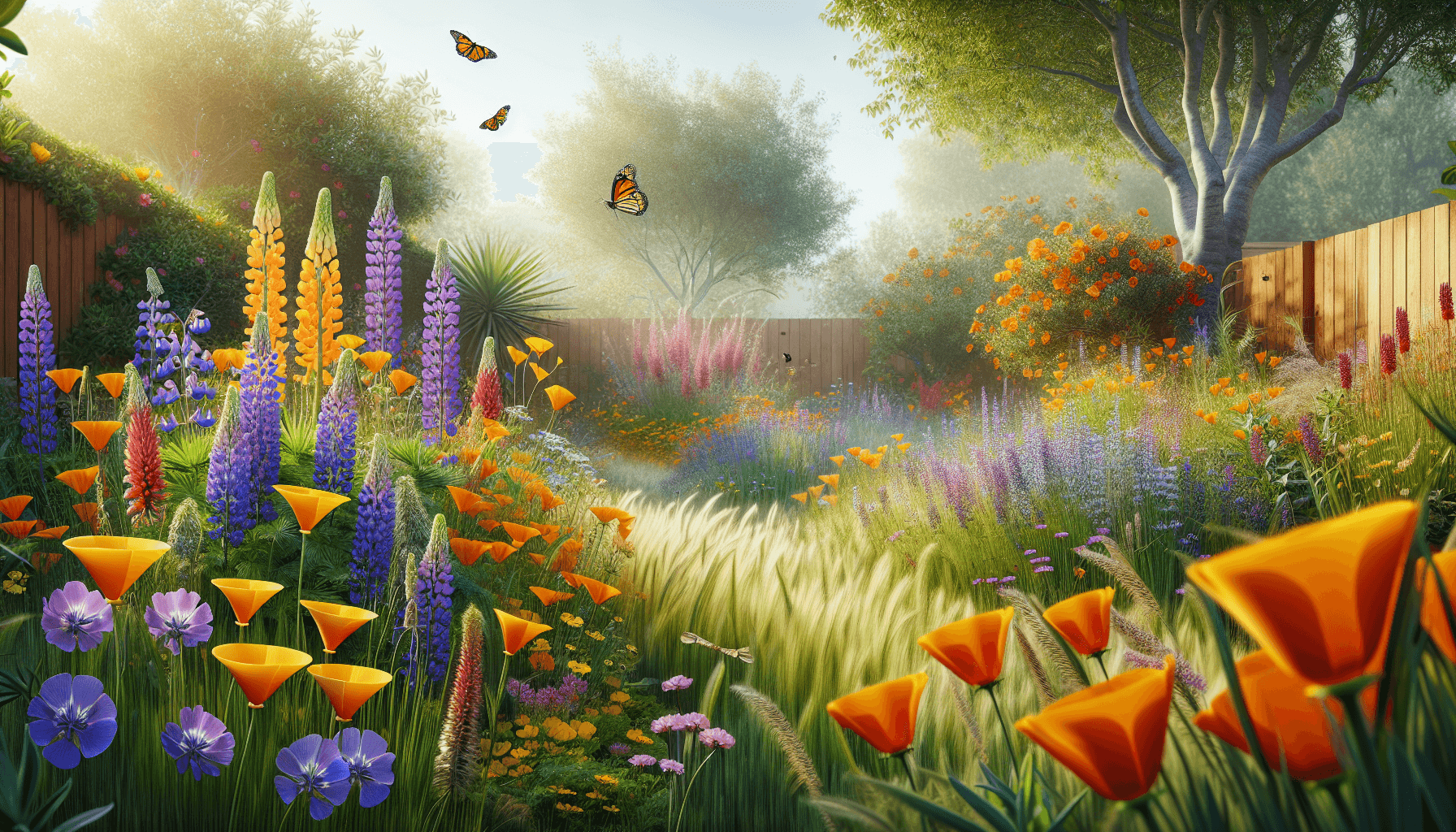Zen-inspired gardens compress landscape into essence—stone, shadow, and a few living lines. In California, the style has matured into a thoughtful translation: authentic in spirit, adapted in practice. Instead of moss lawns and water-hungry maples everywhere, designers use gravel seas, restrained planting, microclimates, and recirculating water to achieve serenity without waste.
The result is a refuge that reads as both ancient and distinctly Californian—a space where daily rituals of raking, pruning, and contemplation create profound calm while respecting our precious water resources.
Zen Design Principles
Japanese garden design follows timeless principles that translate beautifully to California's climate when adapted thoughtfully:
- Reduction: Remove anything that doesn't serve composition or use. Every object earns its place—a granite lantern, a weathered bench, a single pine
- Asymmetry and balance: Arrange stones and plants in odd numbers and triangular relationships; let negative space carry weight
- Journey: Even in small lots, a stepping-stone path shifts perspective—tight at the house, opening toward a framed view or borrowed scene
- Mindful presence: The garden becomes a daily practice of raking, thinning, and listening—rewarding attention with deep calm
Plan on two primary surfaces: raked gravel (karesansui) and planted ground. The planted areas gather around rocks and seating; gravel "water" flows between them, creating a meditative landscape that requires minimal irrigation.
Essential Elements
Raked Gravel: The Dry Stream
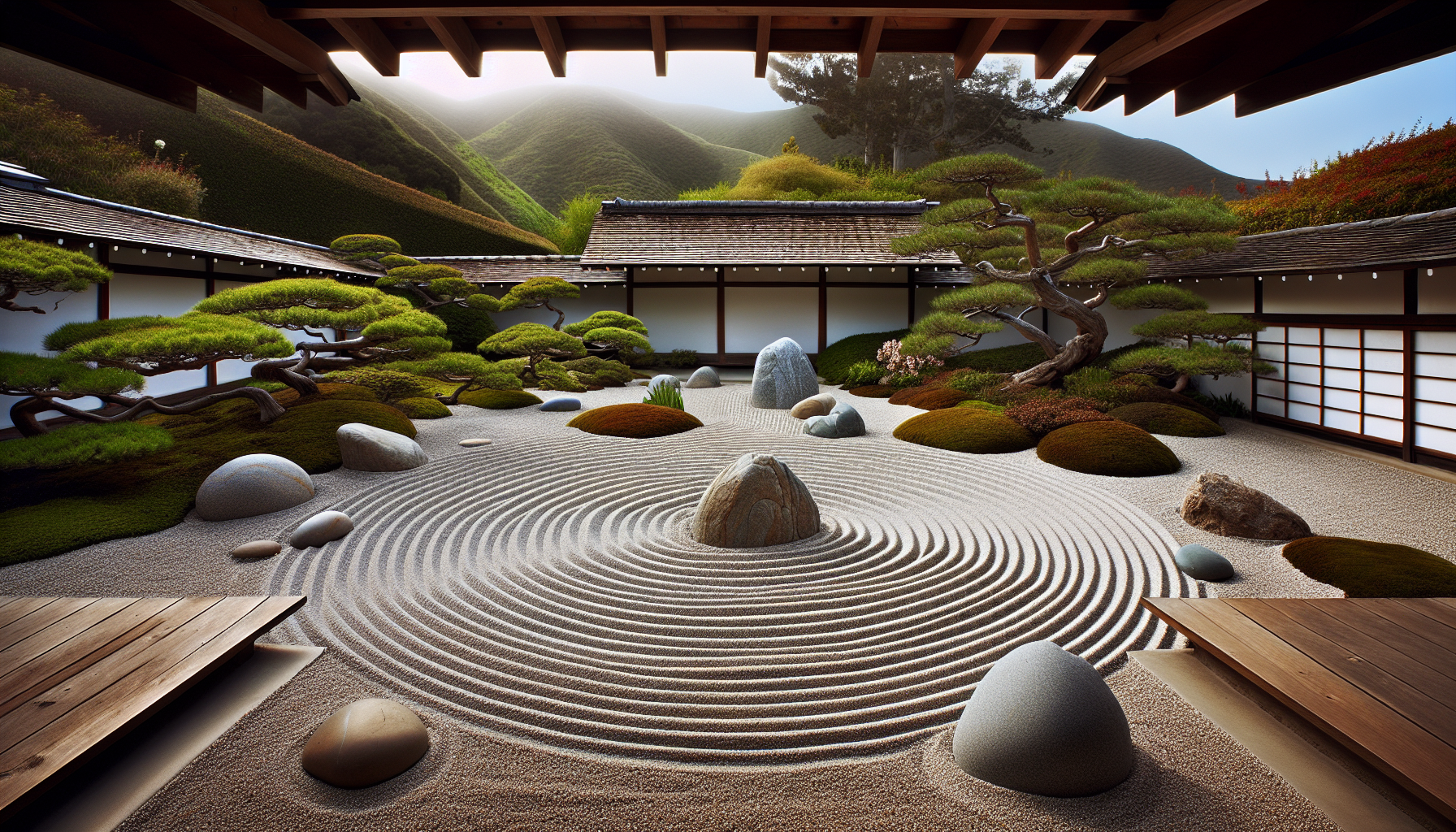
Raked patterns create the illusion of flowing water
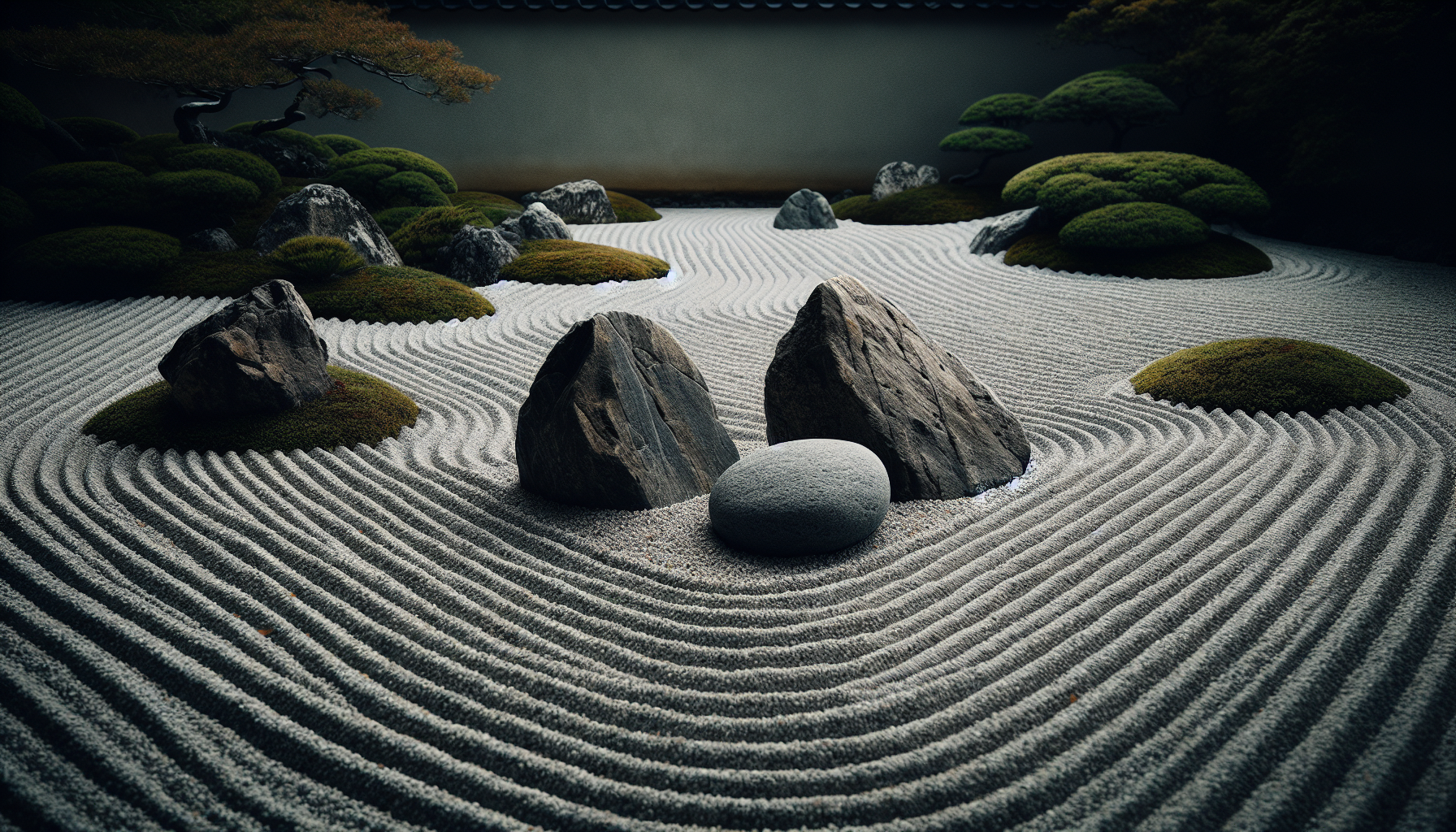
Stones emerge like islands in a mineral sea
Gravel Selection and Maintenance
Material Choice
Choose a single gravel type for the raked plane—3–6 mm angular granite holds lines beautifully. Light gray or tan tones reflect California light without glare. Stabilize gravel on steeper grades with hidden steel edging and subsurface grids.
The Practice of Raking
Raking is a weekly ritual that keeps the plane luminous and discourages weeds. Brush lines around stones to imply "eddies" and "currents." This meditative practice transforms maintenance into mindfulness.
Stone Placement
Use stone that suits California light—basalt, granite, or local fieldstone—selected for shape and "personality." Three primary stones (guardian, worship, and supporting) can structure a composition; smaller "island" stones modulate scale.
Screens and Enclosure
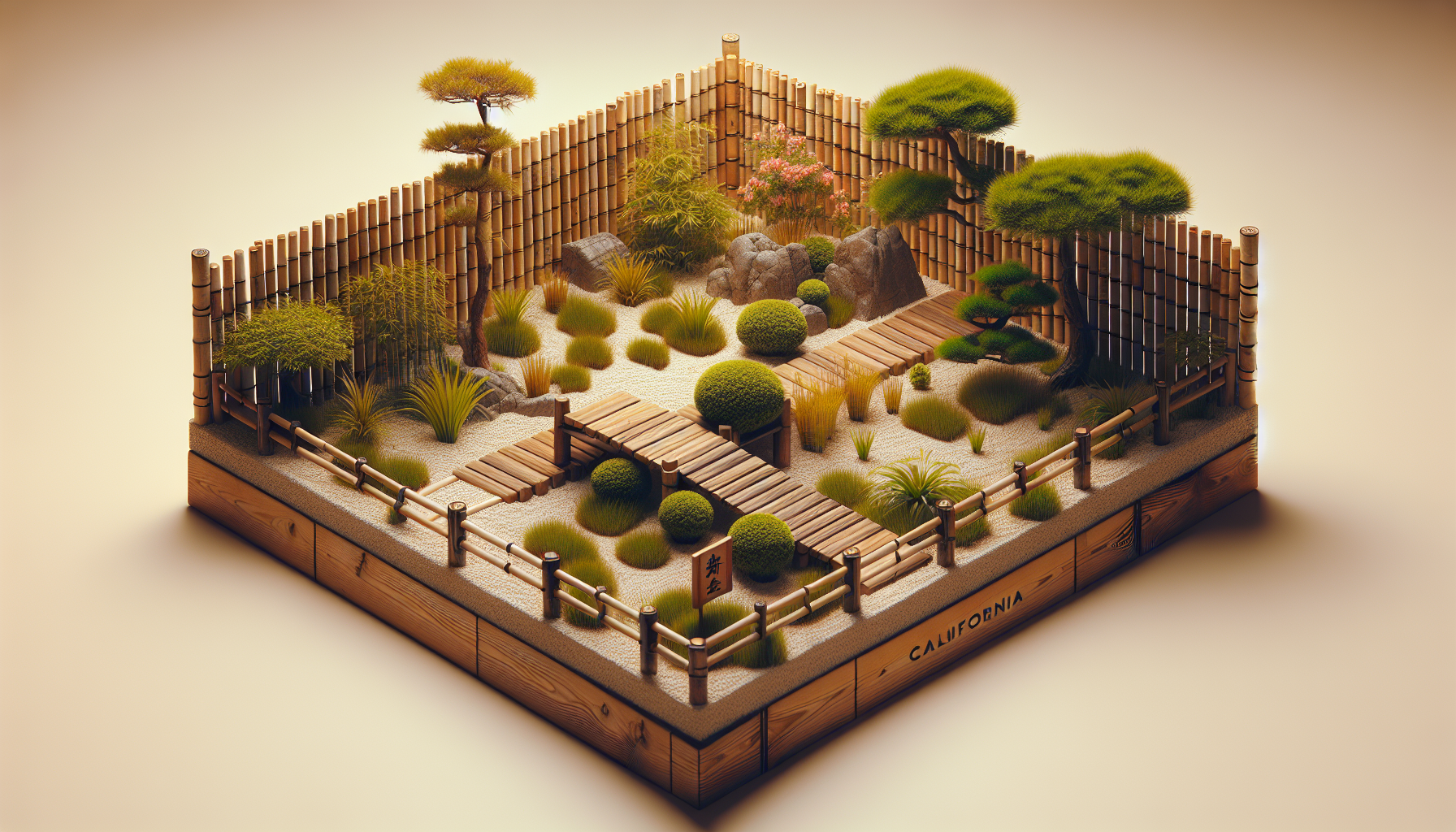
Bamboo screening creates intimate enclosure
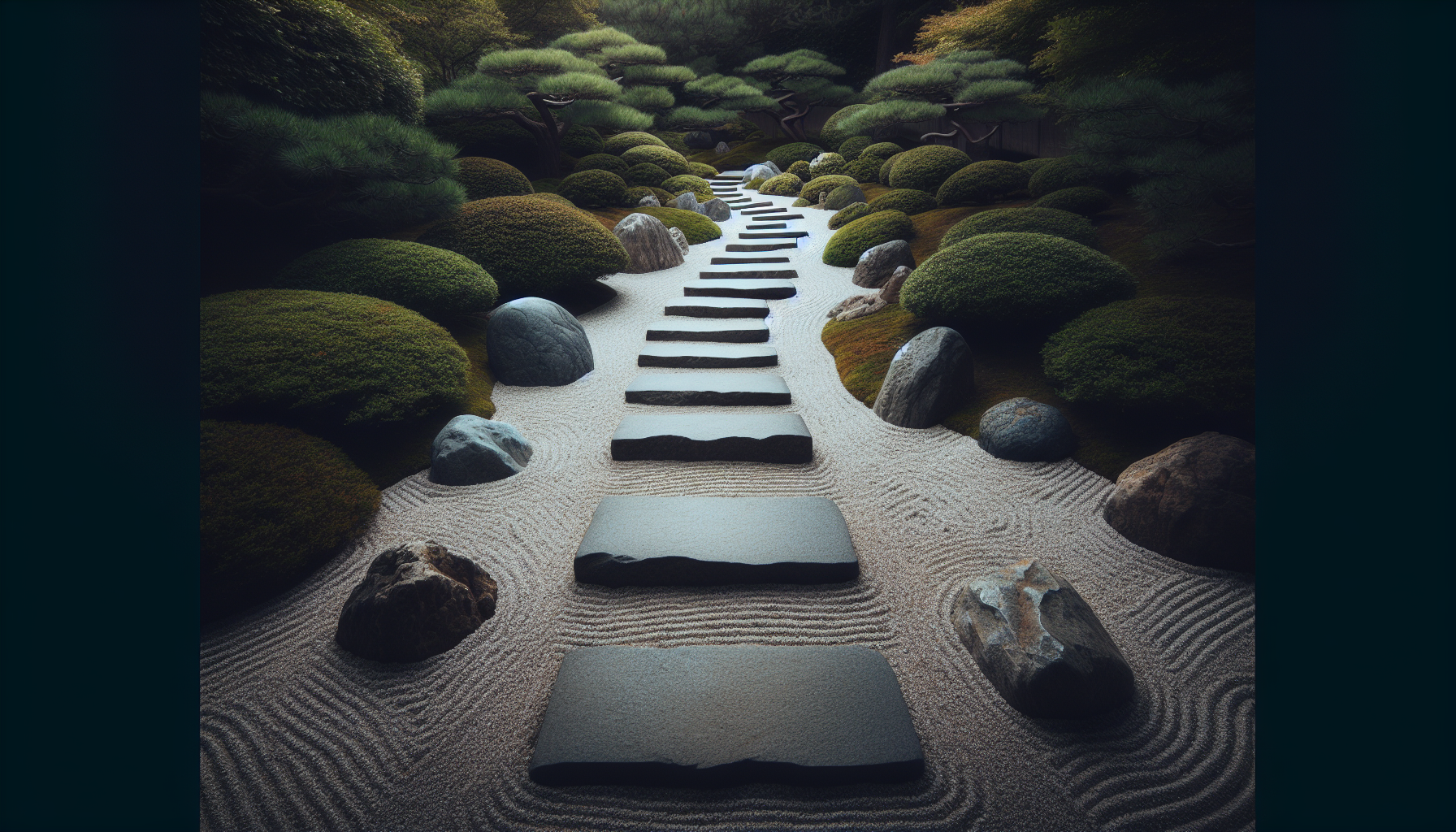
Stepping stones guide the journey through the garden
Creating Sacred Space
Fencing should be quiet—vertical cedar slats, shoji-like panels, or charred wood (shou sugi ban) for depth. A small deck that floats a few inches over gravel becomes an instant platform for tea or meditation.
Wood elements should feel handcrafted: a simple gate, a cedar bench with exposed joinery, bamboo spouts at a tsukubai (stone basin). Metal appears only as discreet edging or hardware in blackened steel.
Water Without Waste
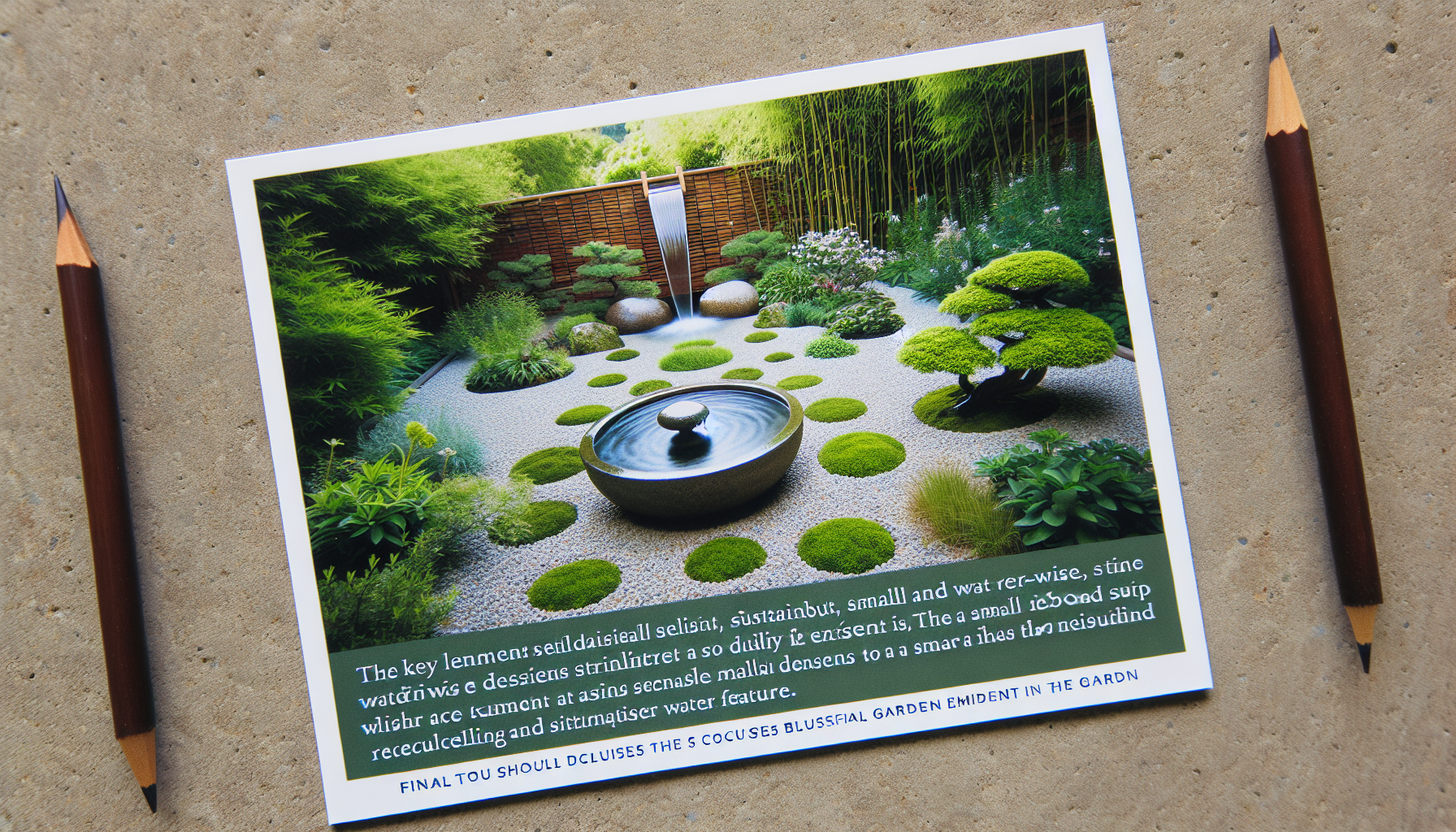
Recirculating stone basin adds sound and ritual without waste
If water belongs, let it whisper. A recirculating basin—hand-chiseled stone or cast concrete—fed by a bamboo spout adds sound and ritual without significant loss. Place it where you can hear it indoors with windows open.
The pump should be accessible via a concealed hatch; design a simple cleanout for seasonal maintenance and consider UV or copper ionization to suppress algae if the basin sits in full sun.
Climate-Savvy Plant Palette
Trees and Structure
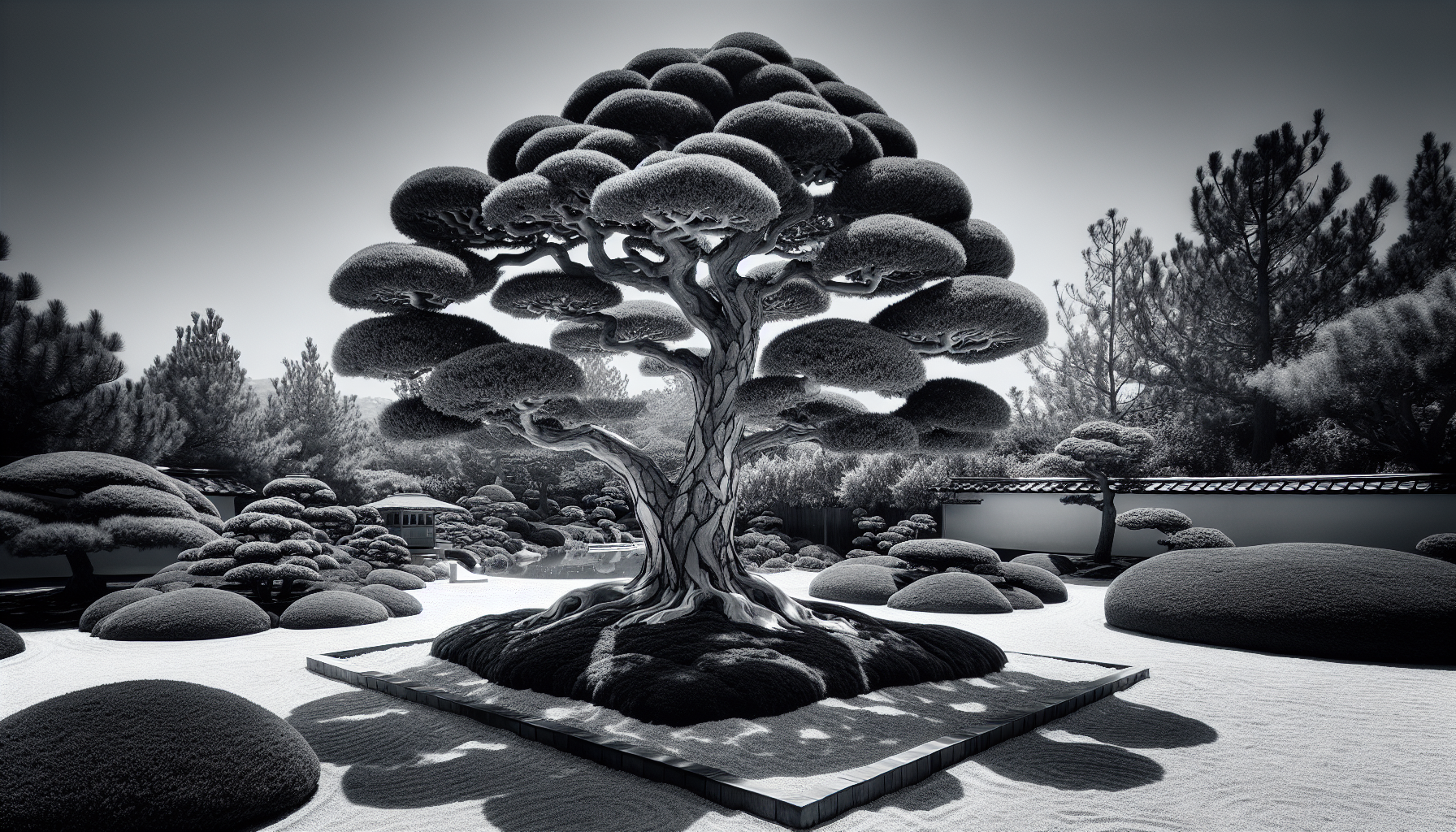
Niwaki pruning reveals the sculptural bones of pine
Recommended Trees
Black Pine (Pinus thunbergii)
Takes coastal wind and pruning; classic niwaki candidate. Extremely drought-tolerant once established. Candle in late spring to control size and create layered pads.
Japanese Maple (Acer palmatum)
Use in protected, partially shaded microclimates or near the coast. For inland heat, choose heat-tolerant selections or plant where afternoon shade is guaranteed. Creates stunning seasonal color.
Ginkgo (Ginkgo biloba)
Autumn gold; slow, architectural growth. Extremely adaptable and drought-tolerant. Choose male cultivars to avoid fruit.
California Redbud (Cercis occidentalis)
Native alternative for spring bloom and sculptural branching. Magenta flowers appear directly on bare wood—a stunning spring display.
Podocarpus (Afrocarpus gracilior)
Evergreen screen that cloud-prunes well. Soft texture contrasts beautifully with stone and gravel.
Shrubs: The Middle Layer
Essential Shrubs
Camellia (coastal shade)
Winter bloom; glossy structure. Requires protected shade in hot climates.
Azalea (cooler coastal)
Controlled color; keep to limited swathes. Best near the coast.
Manzanita (Arctostaphylos)
Sculptural trunks, spring bloom. Prune for bone and line. California native.
Nandina (dwarf, sterile cultivars)
Fine texture and seasonal color without seeding concerns.
Japanese Holly (Ilex crenata)
Compact boxwood alternative. Excellent for low hedges.
Sarcococca (Sweet Box)
Fragrant winter flowers. Thrives in dry shade.
Groundcovers and Grasses
Groundcover mats should be edited like fabric. Where thyme creeps into stone lines, square it off with a knife; where dymondia thins, plug new divisions in fall.
Dwarf Mondo Grass
Lush look with modest water in shade
Creeping Thyme
Moss analog in sun; aromatic
Dymondia
Tight mat between stepping stones
Carex Sedges
Tufted texture; sun to shade
Japanese Forest Grass
Use in moist shade only; stunning texture
Blue Star Creeper
Tiny blue flowers, delicate texture
Irrigation and Hydrozones
Divide the garden into three distinct zones to optimize water use while maintaining the lush appearance where it matters most:
Non-Irrigated Mineral Plane
The raked gravel sea requires no irrigation. This becomes the dominant surface, reducing overall water demand dramatically while creating the meditative centerpiece of the garden.
Very-Low Water Plantings
Pines, manzanitas, dymondia, and thyme masses in sun require minimal supplemental water once established. Run separate valves with micro-drip for shrubs and trees—deep, infrequent cycles. After year one, taper to deep monthly soaks, adjusting for heat waves.
Moderate Shade Pockets
Maples, camellias, mondo grass, and ferns in protected microclimates receive more frequent but brief runs. Use subsurface drip grids for groundcovers. A smart controller plus manual shutoff habit gives the best results: turn the system off during cool fog weeks and early winter rains.
Pruning and the Art of Restraint
This style lives or dies by pruning. Niwaki—the Japanese art of tree shaping—encourages layered pads and visible structure. Pruning becomes a meditative practice that reveals the essence of each plant.
Pruning Techniques
Pines
Candle in late spring to control size. Thin needles and branches to create layered pads that reveal structure.
Maples
Thin in summer to reveal branching architecture. Remove crossing branches and maintain asymmetrical balance.
Manzanita
Selectively raise canopies to show cinnamon bark. Remove lower branches to create sculptural forms.
General Principle
Avoid hedge shears on everything except low borders. Use hand pruners and folding saws for intention and clean cuts.
Annual Maintenance Calendar
Late Winter (Jan–Feb)
Structural pruning on pines (light), thinning of maples before bud-break, renewal pruning on manzanita. Refresh gravel where traffic has thinned it.
Spring (Mar–May)
Tweak irrigation, fertilize container specimens sparingly, re-edge gravel planes. Check bamboo spouts and pump filters; clear algae mechanically.
Summer (Jun–Aug)
Candle pines, lightly pinch new growth on camellias and azaleas. Increase shade irrigation marginally during heat spikes. Rake patterns weekly.
Fall (Sep–Nov)
Best time to plant structural shrubs and pines. Reduce water as nights cool. Collect leaves for compost; keep gravel clear.
Microclimates and Placement
Inland Heat Strategy
Inland heat demands shade strategy. Use trellises with bamboo screens, freestanding timber frames, or tall hedges to create protected pockets for maples and camellias. A north-side courtyard makes a perfect Zen garden: bright but not scorching, with morning sun and afternoon shade.
Coastal Considerations
Coastal gardens can widen the plant list but must address wind. Pin stepping stones in a stabilized bed and choose shorter gravel to keep rake patterns intact. Wind-tolerant pines and podocarpus work beautifully as screens.
Light and Shadow
Lighting should be minimal and warm. Backlight a pine canopy; graze a stone face; place a moonlight-aimed fixture high in a tree to dapple paths. Keep luminaires hidden and beam angles tight to preserve darkness and depth.
Program Within Restraint
A low platform for tea or yoga, a single bench oriented to morning sun, or a tiny roji (tea-garden path) with stepping stones and a gate shifts a courtyard from "pretty" to "used." Containers allow indulgence without changing irrigation logic.
Common Missteps to Avoid
Overplanting
Crowding breaks the negative space that makes Zen design work. Fewer, better plants, repeated. Every plant must earn its place through form, texture, or seasonal impact.
Wrong Species in Hot Sun
Maples and azaleas collapse inland without afternoon shade and dedicated irrigation pockets. Know your microclimate and choose plants accordingly.
Visual Clutter
Too many ornaments dilute calm. Choose one lantern, one basin, one sculpture. Let each element breathe and command attention.
Uniform Gravel Everywhere
Plant islands sharpen the composition and reduce heat glare. Balance mineral with living elements to create dynamic tension and visual relief.
Creating Your Zen Garden
Step-by-Step Implementation
-
1.
Assess Microclimates
Identify sun, shade, and wind patterns. Determine which areas can support shade-loving plants versus drought-adapted specimens.
-
2.
Design the Mineral Plane
Layout gravel areas first—this becomes your canvas. Install edging and subsurface stabilization before adding gravel.
-
3.
Place Primary Stones
Position your guardian, worship, and supporting stones. These anchor the composition. Take time to get it right—stone placement is permanent.
-
4.
Install Structure Plants
Plant trees and large shrubs in fall. These define the garden's bones and provide the framework for everything else.
-
5.
Add Paths and Boundaries
Install stepping stones, screens, and fencing. These elements guide movement and create enclosure.
-
6.
Fill with Groundcovers
Plant ground layer last. These knit the composition together and soften the edges between stone and gravel.
-
7.
Embrace the Practice
Begin your daily rituals of raking, pruning, and tending. The garden becomes a meditation that deepens over time.
A Zen-inspired garden in California is not imitation; it's interpretation. By using drought-adapted plants, disciplined pruning, mineral surfaces, and microclimate intelligence, you can deliver the quiet power of Japanese composition with honest water use.
The garden becomes a daily practice—raking, thinning, listening—rewarding attention with deep calm. This is landscape as meditation, where minimal water creates maximum serenity, and restraint becomes the path to profound beauty.
